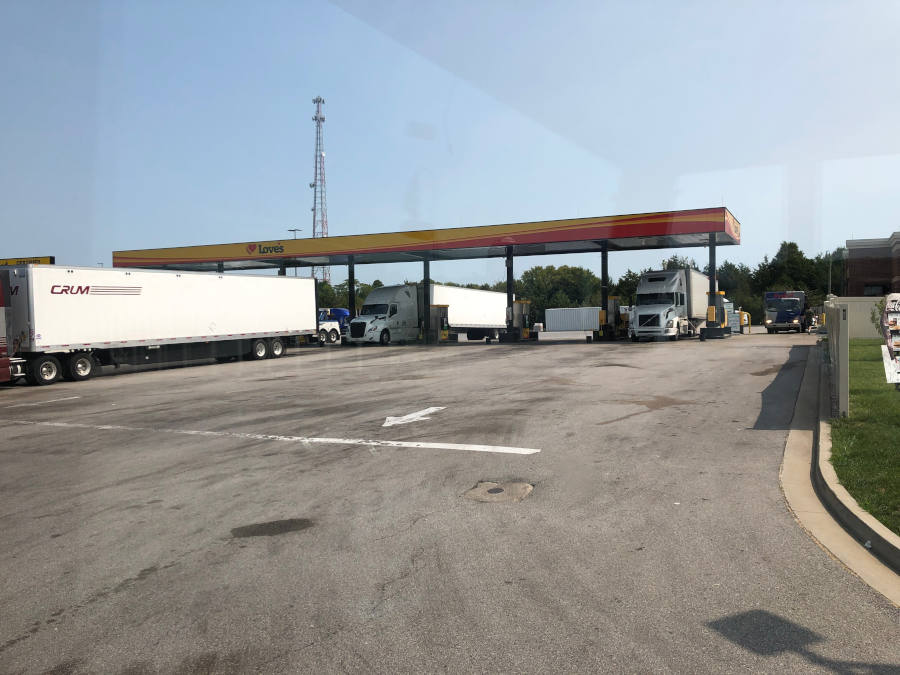When we bought our Class A RV, we received a complete and thorough orientation from our RV dealer. The only thing they didn’t cover was anything about fueling our RV. We had no idea that using truck stop fueling stations could save us money. We didn’t even know that we could use them. Yes, you can Save Money on Fuel at truck stops!
Since the pandemic has skyrocketed RV sales and there are lots of newbie RV owners, I decided to share this information on how to fuel your Class A Diesel Motorhome.
- Don’t Make This Huge Mistake Fueling Your Class A RV!
- Can RVs Use Truck Lanes At Truck Stops?
- 4 Best Tips For Fueling Your RV In a Truck Stop
- 10 Steps Using A Truck Stop For Fueling Your Class A RV
- 1. Learn Where Your RV Fueling Ports Are
- 2. Three Ways To Pay For Diesel Fuel At Truck Stops
- 3. Select The Correct Fuel Pump Nozzle
- 4. Answer The Pump Prompts
- 5. Begin Fueling Your RV
- 6. Using Both Pumps To Fuel Your RV
- 7. What To Do While Fueling Your RV
- 8. Truck Stops Dispense Fuel At Much Faster Rates
- 9. Take A Picture Of The Pump
- 10. Pull Your RV Forward As Soon As You Are Done Fueling
- 2 Best Ways To Save Money At The Fuel Pump
- 12 Tips About Fueling RVs At Truck Stops
Don’t Make This Huge Mistake Fueling Your Class A RV!
Don’t pull into regular gas stations! Even though they may sell diesel fuel, regular gas stations are designed for automobiles and not large Class A RVs. Also, the roofs that cover the fuel pumps are generally not high enough for your RV to drive under without taking the top off your RV!
Can RVs Use Truck Lanes At Truck Stops?
Yes, RVs can use the truck lanes at truck stops, but only for diesel fuel. If your RV does not have a diesel engine, you cannot use truck fueling lanes as they only dispense diesel fuel.
Can You Buy Gasoline In Truck Fuel Lanes?
No, you cannot buy gasoline in truck fuel lanes at truck stops.
Do Truckers Get Mad If RVers Use Truck Fueling Lanes?
We have never had a trucker be unfriendly while we are using truck lanes to refuel our RV. Some truckers even ask questions about our motorhome. However, there is some truck stop etiquette that should be followed!
We do make sure to be courteous and quickly get our fuel and get out of the way by pulling forward to allow the next truck behind us to begin fueling.
Remember, the truckers are trying to earn a living and wasting time sitting behind an RV or truck while the driver in front of them is inside paying would make me mad too!
4 Best Tips For Fueling Your RV In a Truck Stop
- Use Fueling Gloves- Truck stops are generally very dirty and are very busy with travelers from all over the country. It’s especially important during the COVID Pandemic that you don’t carry whatever is on the nozzles into your RV.
Some stations have fueling gloves available that you can wear and throw away, but don’t plan on it. Carry a box of non-latex or Nitrile disposable gloves with you to use and discard at the pump.
Tip: Why use non-latex gloves when pumping diesel fuel? Because non-latex or Nitrile gloves do not break down when exposed to diesel or gasoline. - Use Fueling Shoes- There’s always diesel spilled at the pumps and you don’t want to track that in your RV. Have a pair of slip-on shoes that you tuck in an outside bay that is easy to access and change shoes when fueling. Store your “fueling shoes” in a plastic or airtight container to avoid diesel smells and stains inside the basement of your coach.
- Select The Correct Diesel Type At The Pump-
Only Select Tractor Fuel- Not Reefer Fuel At the Pump! - Pull Forward- When you finish fueling your RV even if you need to go inside for any reason pull forward to allow the next truck (or RV) to pull up to the pumps. Remember, truck stops are busy so even if there is no one immediately behind you there may be one waiting while you are inside!
10 Steps Using A Truck Stop For Fueling Your Class A RV
Step By Step Process For Fueling Your Class A RV With Diesel
1. Learn Where Your RV Fueling Ports Are
This might sound like common sense, but it’s easy to overshoot the pumps so the fuel hose doesn’t reach. Remember, you cannot back up if you are towing a vehicle, so if you pull too far forward you are going to have to pull through and get back in line to try again.
If you have someone traveling with you, have them get out right before you pull into the pump to let you know when you are in the right position to reach so that the nozzle will reach your fueling port.
Truck Stops can be very busy- use caution when exiting the RV!!!
Once you get used to doing it a few times, you will be able to judge when you are in the right position.
Tip: Check with your RV manufacturer to confirm how many gallons your motorhome fuel tank holds. There is not a standard size fuel tank for all RVs, and you will need to know the capacity to estimate how much fuel you need to fill up.
2. Three Ways To Pay For Diesel Fuel At Truck Stops
You have 3 choices when paying for fuel at truck stops- Cash, Regular Credit Cards, or Fleet Cards.
Cash Payments For Diesel Fuel At Truck Stops
- Pull into an available lane.
- Check your fuel gauge and estimate how many gallons you think you will need.
- Go inside and pay the attendant.
- Pump your fuel and when finished, pull forward to allow enough room for the next customer to pull into the pump.
- Go back inside for change or a receipt.
Tip: It’s a good idea to overestimate a little to make sure you can fill your tank without asking the attendant to restart the pump.
Using A Regular Credit Card At The Truck Stop Diesel Pump
Now that you are in the right position to get fuel, the next step is activating the pump. It’s not the same as a regular gas station. Most truck stop pumps are set up for commercial fleet cards. This means that unless you have a pump authorization card, you will have to go inside to get the pump activated.
Pump Fueling Limits
Some pumps will let you use your credit card to activate them at the pump, but then they cut off at $100. If you have a 150-gallon fuel tank, that means you are going to have to restart the pump at least once to finish fueling.
Using Your Credit Card Inside The Truck Stop
If you can’t use your credit card to start the pump, you will need to go inside and get the cashier to activate the pump. Before you go inside, take a guess at how many gallons of diesel you will need so that they can authorize that amount. We always overestimate how much fuel we are going to take so that we don’t have to make two trips to the attendant.
If our fuel gauge is showing half full on our 150-gallon tank, I’ll generally ask for 90 gallons. They only charge you for whatever amount you pump, so it saves us time.
Using A Fleet Card To Pay For Diesel Fuel
There are a few different Fleet Credit Cards available that allow RVers to pay at the pump as commercial trucks do. One is the Flying J RV Plus Card and another is the TSD EFS Card.
Flying J RV Plus Card
Flying J RV Plus Card is a partnership with the Good Sam Club and is a type of fuel credit card that requires membership in the Good Sam Club to receive discounts. Their RV Plus Card program offers $.08 – $.09 per gallon discounts based on the level of Good Sam Club membership you purchase. You must apply for the card and you have to pay the card off every month in full. Not a Good Sam Member? Here’s more information, first join the Good Sam Club, then here’s the Flying J RV Plus Card
Flying J RV Plus Card is a partnership with the Good Sam Club and is a type of fuel credit card that requires membership in the Good Sam Club to receive discounts. Their RV Plus Card program offers $.08 – $.09 per gallon discounts based on the level of Good Sam Club membership you purchase. You must apply for the card and you have to pay the card off every month in full. Not a Good Sam Member? Here’s more information, first join the Good Sam Club, then here’s the Flying J RV Plus Card
TSD Logistics Fuel Discount Program
TSD is a bulk freight transport company that came up with a great idea to save money on fuel for its fleet. The more fuel that a logistics company buys for its fleet, the better the discount. They realized that if they offered their program to RVers with diesel RVs, that would help increase the overall discounts by purchasing more fuel.
- You can only use the card at the commercial truck pumps, not the RV or car lanes.
- The TSD EFS card is not a credit card or a membership program.
- The EFS card is for diesel fuel only, not gas.
- You can use it at all major truck stops to buy diesel, DEF, and other goods in the store. You will only get discounts on diesel fuel and not every truck stop offers the same discounts.
- Once you join the program, you get discounts at those truck stops that participate in the program (at last count over hundreds of them).
- They have an app for your phone that makes it easy to find participating fuel stops and prices.
- The price you will pay per gallon is listed on the TSD app, not on the pump.
- Unlike your personal credit card, the fuel pump doesn’t shut off at certain limits.
- Once you fuel up using your EFS card, the information is electronically transmitted to TSD and they auto-draft the total amount due with discounts applied and their small service fee from your bank account.
- You must make sure that you have funds in your account to cover the fuel costs as they will normally debit your account in 24 hours.
I’ll add a link with a detailed review of the TSD EFS card and exactly how it works, but in September 2020 on our East Coast trip, we saved 83 cents per Gallon in one station alone!
3. Select The Correct Fuel Pump Nozzle
There may be two different nozzles at the pump, a diesel, and a DEF. Unfortunately, there are no legal requirements that call for universal color coding for fuel pumps, which you would think there would be! That means dispenser nozzles can be any color the retailer decides to use. Make sure you read the front of the pump to choose the correct nozzle. Diesel nozzles are generally larger than DEF nozzles.
Don’t make the mistake of using the wrong nozzle and dispensing anything other than diesel into your fuel tank!
4. Answer The Pump Prompts
The next step is to answer the questions on the pump screen so that it will allow you to pump fuel. They vary based on the truck stop, but here’s a few we have seen:
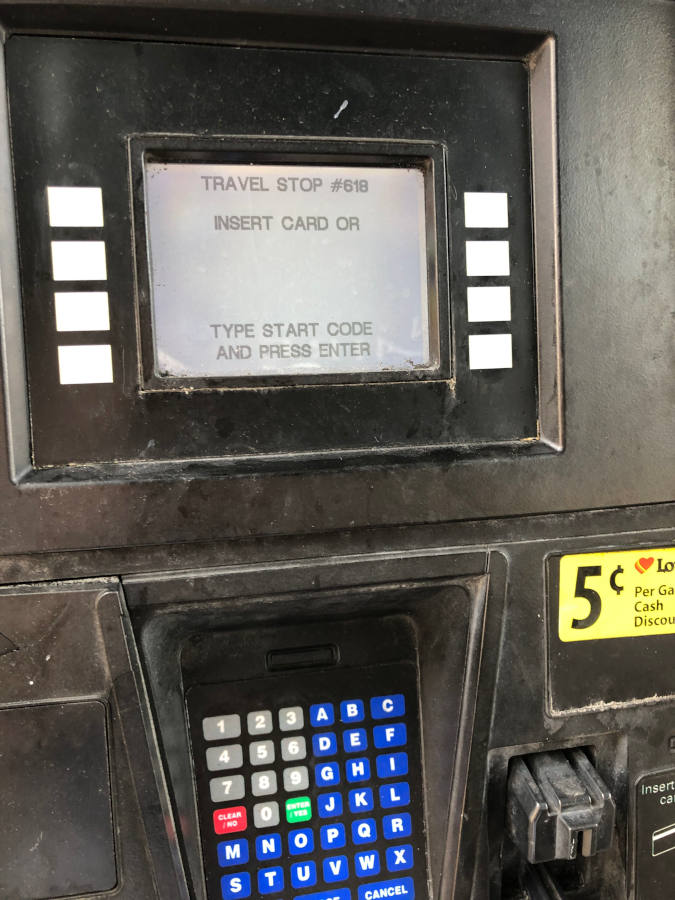
Swipe Fleet Card- this question is for commercial truckers with fleet cards. Chances are you don’t have one unless you have a TSD card (which you probably haven’t gotten yet!), so just hit the Skip Button on the screen.
If you are at a Love’s Truck Stop, you will probably get a prompt to swipe your Love’s Reward Card. This is a loyalty rewards program different from the RV Plus Credit Card. It’s mainly focused on commercial truckers and allows you to earn points based on the amount you spend in Love’s locations. If you have one now is the time, if not hit Skip.
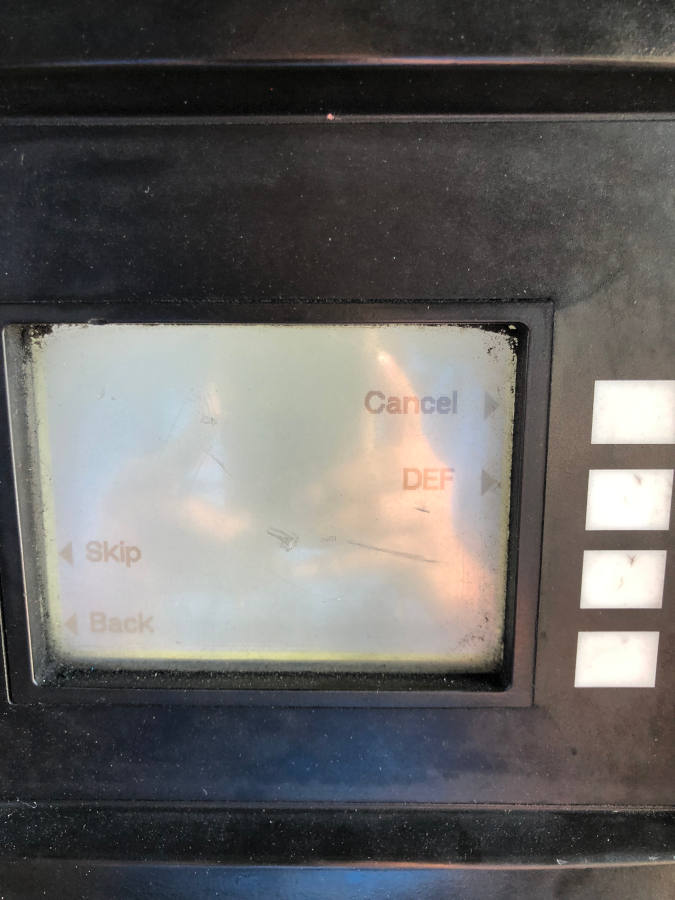
DEF– What Is DEF? DEF is Diesel Exhaust Fluid and is required for all diesel engines to keep them operating within federal emission guidelines. Not all diesel pumps dispense DEF, so you won’t always see the question on the pump. If you aren’t getting DEF, hit the Skip Button.
If DEF is available at the pump, there will be a separate nozzle clearly marked as DEF. Make sure to check your DEF gauges to see if you need it and select it or let the clerk know when requesting fuel authorization.
More on DEF and your RV to come.
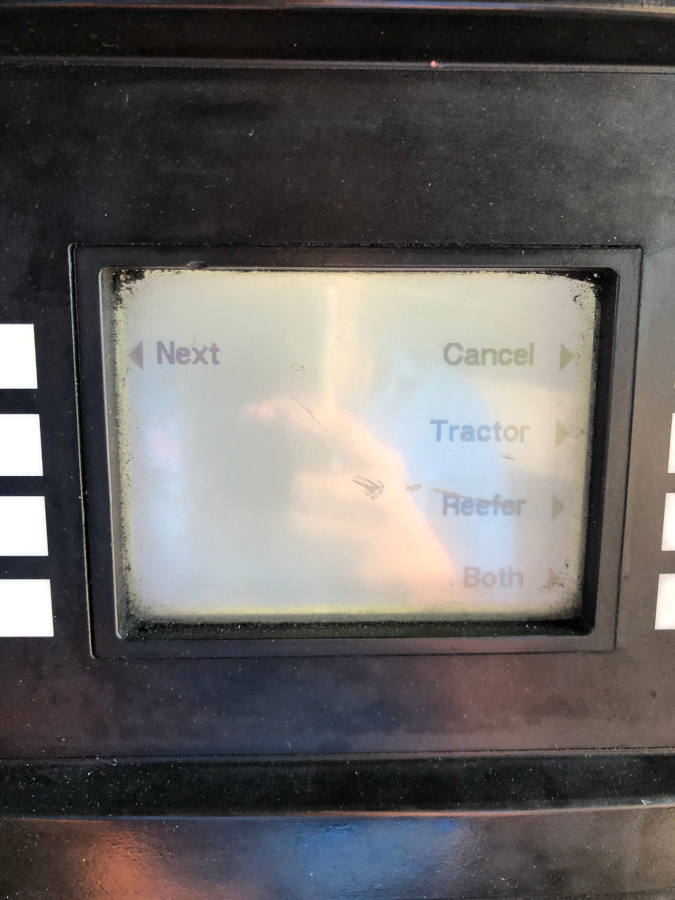
Tractor, Reefer, or Both? This is the most important question on the screen and you want to make sure you get this right!
Many commercial diesel truckers have refrigeration units that also burn diesel fuel, and that fuel is taxed at a lower rate than road diesel or Tractor fuel. Reefer refers to refrigeration unit fuel. As an RV, you will always choose Tractor, not Reefer or Both.
While Tractor and Reefer fuel are the same, the Reefer fuel is dyed pink to distinguish the difference. In some states, it is perfectly legal for law enforcement to dip your tank without your consent to make sure that you aren’t using Reefer fuel in your RV to avoid paying the full fuel road tax.
While Reefer fuel will not hurt your RV, the fines that come along with using it if you get caught can be very expensive!
- CONTROL NUMBER- If you have the TSD EFS Card, this is where you enter your personal control number for your card. I’ll link to a detailed post on exactly how to use the card in another post.
- Cash Advance?- If you have a TSD EFS Card, you have the option of receiving a cash advance against your account. Remember that this amount will be added to your fuel total and will be drafted from your account within 24 hours.
- Additional Products or Any Other Station Services– This question generally refers to the use of showers or other facilities made available for commercial truckers, just hit Skip here too.
Remember, if you accidentally hit the wrong button you can just hit Cancel and start over. Now you should be ready to fuel up!
5. Begin Fueling Your RV
Now that you have answered all of the questions at the main diesel pump, grab the fuel nozzle and follow the instructions generally printed on the pump. That means either lifting the pump activation lever where you removed the nozzle from or selecting the diesel button that should be flashing. Insert the nozzle into your RV fueling port and squeeze the handle to begin pumping.
Most of these dispensers will allow you to lock the handle in the open position. Use the small metal tab to lock it open and set it, the pump will automatically shut off when the pump recognizes your tank is full.
Why Are There 2 Diesel Pumps In Truck Lanes?
The truck refueling areas almost always offer dual pumps, one on each side, so large trucks and RVs can fill both tanks at once. These are called satellite pumps.
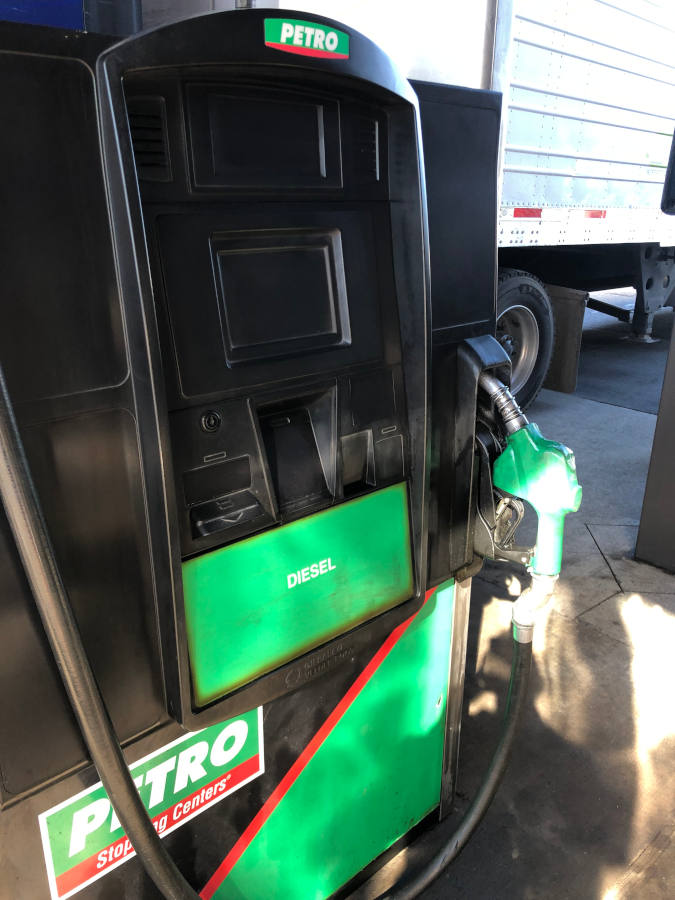
6. Using Both Pumps To Fuel Your RV
If you have fueling ports on both sides of your RV, go to the satellite pump on the passenger side of your RV and grab the nozzle and insert it in your right fueling port.
Lift the lever where you picked up the nozzle from on the pump and squeeze the handle to begin pumping. Lock this nozzle into the open position with the metal tab.
Once the main pump senses the tank is full, it will shut both nozzles off automatically.
7. What To Do While Fueling Your RV
Even with the fast pumps at truck stops, you will still have a few minutes to wait. DO NOT leave your RV! There are generally trucks or RVs waiting behind you to get fuel, so don’t walk away while fueling.
What should you do while fueling your RV? This is a perfect time to use the long window washer poles provided at most truck stops to clean your RV windshield.
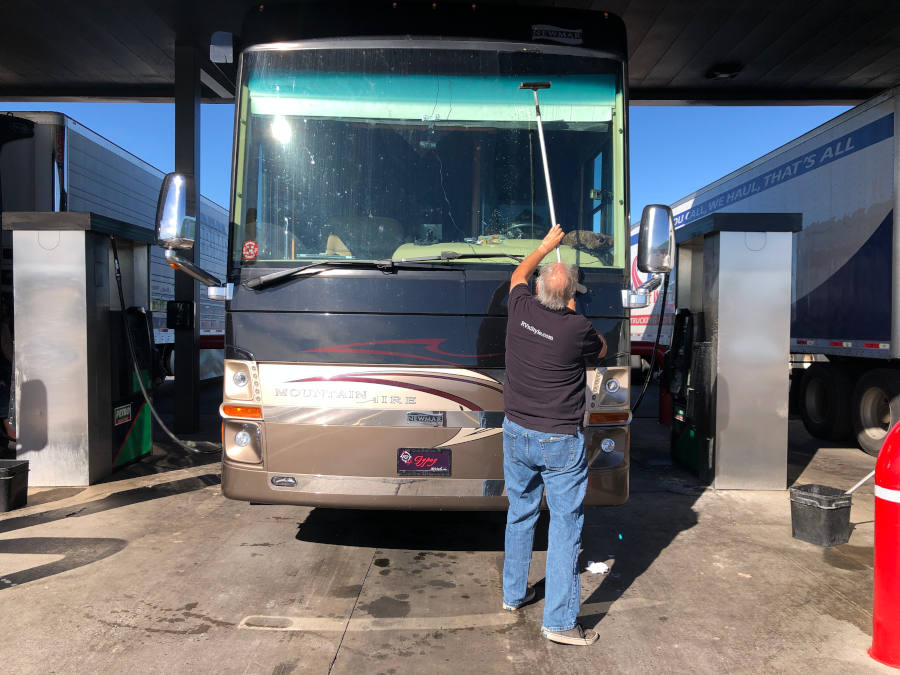
8. Truck Stops Dispense Fuel At Much Faster Rates
Because time is money for truckers and trucks have much larger fuel tanks, these stations dispense fuel at much faster rates than regular fuel pumps. Even though the pumps do shut off automatically, it’s pretty common for a little diesel fuel to splash out of the fueling port just as the pump is shutting off the fuel flow.
It happens to us and hasn’t caused any damage to our RV. If there is a water hose at the pump and we can do it quickly, after replacing the fuel cap and closing the door (you don’t want water in your diesel tank!), we rinse the diesel overflow off. Another reason why you should be wearing fueling shoes!
9. Take A Picture Of The Pump
The pump shuts off and your RV tank is full, what should you do next? You should track your RV fuel purchases. This is important for a few different reasons. First, you can track when you last bought fuel so you will know how old the fuel is in your tank. The second reason is in case your fuel gauge is not entirely accurate, you can calculate how much fuel you should have in your tank. The last reason is if you have mechanical issues that are traced back to bad fuel, your insurance company can use that record to help recover the costs of repairs from fuel companies.
The simplest way to track your fuel purchases is to take a quick picture of the pump to record how much fuel you purchased and at what price.
Make sure the picture shows the full readout on the pump screen and that you have the date and location tracking turned on in your phone (most cell phones automatically do this).
Don’t worry about getting the perfect picture, just take a quick picture and get into your RV.
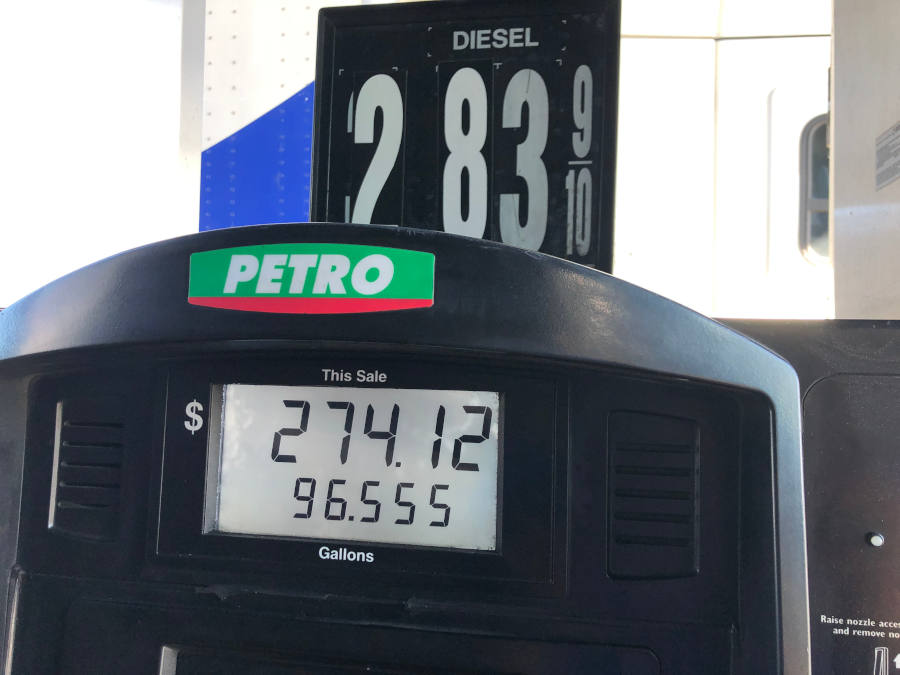
Tip: I always take a picture of the fuel pump and my receipt to keep track of fuel purchases and document that we paid the correct taxes showing the amounts paid for fuel.
10. Pull Your RV Forward As Soon As You Are Done Fueling
As soon as you finish fueling up, pull your RV forward to allow the next vehicle access to the pump. Don’t make them wait while you are inside the station paying for fuel!
2 Best Ways To Save Money At The Fuel Pump
- Join An RV Membership Club- Join Good Sam and you can save .08 per gallon on diesel fuel at Pilot and Flying J truck fuel stations.
- Use a Fuel Discount Program like TSD
Follow these 10 Steps and tips on using a Truck Stop to fuel your Class A RV and you should have no problem finding ways to save money on fuel!
Want more RV Tips and tricks to save money? Here are 19 Ways to Save Money RVing. Don’t forget to subscribe to out list to get more tips!
12 Tips About Fueling RVs At Truck Stops
Follow The Signs That Guide Truckers Into Truck Fuel Lanes
Pick a lane and remember that you may have a longer wait since trucks (and RVs like yours) have much larger fuel tanks than cars!
Tip- Sometimes there are signs directing RVs to specific lanes- DO NOT follow them! Many RVs are smaller and are not towing vehicles which makes it easier for them to maneuver. Stick to the truck lanes and you will be sure to have enough room.
REMEMBER- if you are towing a vehicle you CANNOT back up and will have to unhook your tow vehicle!
What Is A Diesel Satellite Pump?
A diesel satellite pump is a pump on the other side of the vehicle from whichever side the main pump is on. Many commercial trucks have dual saddle tanks on either side of their rig. Satellite pumps allow them to fuel both tanks at the same time.
It’s sometimes called a slave pump because it doesn’t have the computer screen or any other information since it is controlled by the pump on the main side.
How Does The Diesel Satellite Pump Work?
The idea is that if you have fueling ports on both sides of your RV like we do in our Class A RV, you can fuel from both sides at the same time. Remember that the side with the computer screen on the pump controls both pumps.
Are Diesel Pumps Dirty? Why?
Yes, diesel pumps are dirty because they are used often by trucking fleets and RVs. The high volume of turnover of fuel means fewer chances of you getting old fuel which is not good for your RV and can force you to make costly repairs!
Why Do Truck Stops Have Dispatchers?
Sometimes, in really busy truck stops there will be a dispatcher directing trucks and RVs to the correct lanes to help speed up the process. Just pull into the line and they will direct you to the correct lane.
What To Do If There Is No Fuel Dispatcher?
If there is no dispatcher, just pick whatever lane you think is good. Most trucks have 200-300-gallon tanks and take longer than RVs to fuel up since their tanks are so much bigger.
Where Do You Find Diesel Fuel?
You can look on your GPS unit, but our Garmin doesn’t display just diesel stations, it shows all fuel stations. That doesn’t work for those of us driving diesel pushers. We look for Loves, Pilot/Flying J, and other truck stops as we cross the country.
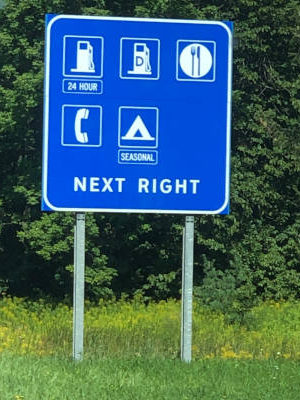
If you are on major highways, look for the blue fuel signs that are at upcoming exits. If diesel is available, they will have a picture of a gas pump with a D in the center. If gas and diesel are both available, they will have two pumps on the sign- one with a D and one without. This doesn’t guarantee that you will be able to fit into the fueling station, but it is a good indication that diesel is available.
What Mileage Do You Get On A Diesel RV Pusher?
On an average, our 44’ RV towing a Chevy Equinox SUV gets around 5.5-6.6 miles per gallon at highway speeds depending on where we are traveling, and whether we are running our generator. In the mountains, we get less.
How Much Fuel Does A Diesel Generator Use?
We contacted Cummings Diesel and learned that our 10 KW diesel generator burns less than 1 gallon per hour.
RV Fuel Gauges Are Not Always Exact!
We have a Newmar Mountain Aire on a Freightliner chassis and we have a 150-gallon fuel tank. Even though we have an additional fuel monitor system on our RV, we knew that vehicle fuel gauges are not always exact. Plus, we frequently run our generator while driving to exercise it and that fuel burn is not calculated in the fuel monitoring system.
When our low-level fuel light came on, we contacted Freightliner to find out how much fuel we should have left once the warning light comes on to help us determine how accurate our fuel calculations were. Freightliner told us that the fuel warning lights are designed to come on when there is approximately 20% of fuel remaining in the tank.
You don’t want to run out of fuel in your RV, it can be a very costly repair!
When Should You Stop Your RV For Diesel Fuel?
The short answer is it depends on where you are traveling, and whether diesel fuel at truck stops are easily available. We found that in the northeast, there were not as many truck stops and we decided to refuel when our fuel gauge showed half a tank. In the southeast, when truck stops are more prevalent we waited until we had 1/4 tank of fuel remaining.
RV Fuel Planning
It’s also a good idea when you develop your RV travel itinerary to build a fuel plan into it. If you use a fuel travel app, you can try to plan ahead to schedule stops where fuel is cheapest. We’ve saved as much as .83 per gallon by planning ahead. That can add up when you have a 150-gallon fuel tank!

